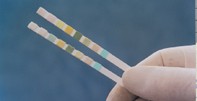Peer Reviewed
Feature Article Paediatrics
Investigating the child with unexpected proteinuria
Abstract
About 5% of well children will be found to have proteinuria on dipstick examination. Although most instances will be benign, clinically significant renal disease occurs in a few cases. The urinary protein to creatinine ratio is the key investigation.
Key Points
- About 5% of children will be found to have proteinuria on dipstick examination.
- The urinary protein to creatinine ratio is the key investigation when a finding of proteinuria is unexpected; normally this ratio will be less than 20 mg protein/mmol creatinine; a higher, fixed ratio is associated with a high incidence of clinically significant disease and warrants further investigation.
- Most instances of unexpected proteinuria are due to (benign) transient proteinuria, which is found in association with fever and following exercise.
- Other types of proteinuria are postural proteinuria (benign) and fixed proteinuria (associated with disease).
Purchase the PDF version of this article
Already a subscriber? Login here.

